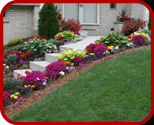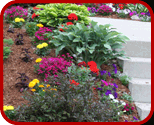 |
 |
 |

|
|
|
 |
| |
|
| |
Lawn Tips
| 1. |
Cut grass when it needs it – If you cut off more than one third of the leaf surface the grass goes into shock and begins to turn yellowish to brown in color. If the desired height is 3 inches then cut it when it is 4 inches tall. That might mean cutting the grass more than once per week, especially in the spring and fall. |
| 2. |
Cut at the higher setting – This will encourage grass roots to go deeper which will enable the grass to be drought tolerant, as well as give the appearance of a greener lawn. Taller grass also shades the soil keeping t cooler, preventing weed seeds from germinating, and letting grass be the dominant one. |
| 3. |
Water thoroughly and infrequently – One inch of water per week is sufficient to keep grass healthy and growing vigorously. Heat stress during the summer months will cause the grass to enter a state of dormancy if water is scarce. That is fine, it will turn brown and when moisture is sufficient it will wake up again. However, this is an opportunistic time for weeds and insects to take residence in the lawn. Watering in the early morning is best because it is not as windy and temperatures are lower so less water is lost to evaporation. Night time watering is not as beneficial because the wet grass blades encourage disease such as Pythium Blight, Powdery Mildew and other fungal type diseases. |
| 4. |
Feed your lawn four pounds of nitrogen per 1000 sq ft per year – fertilizing your lawn is vital to maintaining a thick healthy lawn. Using slow release nitrogen is best because it won’t encourage top growth like fast release nitrogen will. Don’t bag the clippings, since the grass clippings are mostly water they will disappear quickly, adding nutrients and organic matter. Doing so will not contribute to thatch buildup. When grass is thick and lush, it is very difficult for weeds to get a foothold in the lawn, thus minimizing or eliminating the need for herbicide use. |
| 5. |
Kill weeds when they are actively growing – Don’t apply herbicides when plants are drought stressed because they won’t take in the herbicide systemically as well as when they are not stressed from heat, which would mean multiple applications to be as effective. Late Spring and early Fall are best. |
| 6. |
Overseed with a better variety of grass – New varieties of grass with endophytes are available. Endophytes are bacteria and fungus that live in the grass blade without affecting the grass itself. This is beneficial because it discourages insects from feeding on the lawn, they will die or become sick if they do. The new grass varieties are also darker green in color, more disease resistant, tolerate foot traffic better, and are more drought tolerant as well. The best time to overseed is late summer, early fall because soil temperatures are still warm allowing the seed to germinate quickly. The grass will also get nice and dewy in the mornings. |
| 7. |
Aerate your lawn once per year – The best method of aerating is core aeration. This is where plugs of soil are pulled from the ground. This is beneficial for a multitude of reasons.
- Relieves compacted soils
- Enables air, water and nutrients to reach the root zone.
- Microorganisms are brought to the surface which naturally helps to eliminate thatch.
- Overall health of the grass is greatly increased.
- It will naturally level uneven surfaces over time.
- Earthworms will be much happier doing their jobs.
Leaving the plugs on the surface will look like a flock of geese landed in your yard, but they will disappear quickly. Pushing tines into the ground without pulling plugs of soil out of the ground is not as beneficial and actually add to soil compaction |
| 8. |
Sharpen your mower blade – A dull blade rips and tears grass injuring the plant. This not only makes grass less attractive in appearance, but is also vulnerable to insects and diseases. |
| 9. |
Mow in a different direction each time – This will reduce soil compaction. This is especially important if you have a heavy riding mower. It also makes the grass stand up better for a more even cut. |
| 10. |
Use the right type of grass for the areas needing repair – If your repairing a area under a mature tree with a lot of shade, use a shade type of seed such as Creeping Red Fescue or Chewing’s Fescue for shady areas in the yard. Sod, while giving immediate satisfaction usually won’t hold up well in the shade. Over time it will thin out and die. Sod is best in sunny areas because it is mostly Kentucky Bluegrass. It is best to buy grass seed that is a mix of several types of grasses to meet all needs if you have a mix of sun and shade throughout your yard. If your lawn is mostly in the sun or all sun, sod will be great. However, there is certified sod quality grass seed that is more economical than sod. |
Top |
Common Mistakes
| 1. |
Cutting grass too short (scalping), 3 inches is recommended. |
| 2. |
Cutting with a dull blade (invites disease), Sharpen blade at least once a year. |
| 3. |
Cutting more than one third of the grass blade (shocks the grass), cut often. |
| 4. |
Shallow watering (less than one inch per week), Causes shallow roots. |
| 5. |
Overwatering (more than one inch per week), Contributes to excess thatch. |
| 6. |
Nighttime watering (invites fungal diseases), Early morning is best. |
| 7. |
Overfertilizing/underfertilizing (too much in one area or missed spots causing stripes in the lawn), Calibrate equipment properly. |
| 8. |
Not fertilizing the proper amounts of nutrients (Nitrogen, Phosphorous, Potassium), Use a balanced slow release fertilizer. |
| 9. |
Growing grass in the wrong areas (even shade grasses require some sunlight), Consider ground covers for those areas. |
| 10. |
Not using a pre-emergent at the right time in the spring (dependant on soil temperature) once soil temperature reaches 55 degrees for about 3 consecutive days crabgrass will start to germinate. |
Top |
Common Myths
| Myth: |
Thatch is bad. |
| Fact: |
A thin layer of thatch (1/2 inch or less) is desirable and beneficial just like a layer of mulch is in a garden. |
| Advice: |
Aerate when thatch is more than 1/2 inch. |
|
|
| Myth: |
Leaving clippings on the lawn causes thatch. |
| Fact: |
Clippings are mostly water and contain nutrients. Thatch is dead stems and crowns of the grass. As long as the clippings aren’t the size of hay bales they will be beneficial to leave on the lawn. |
| Advice: |
Mow often, never remove more than one-third of the grass height at once. If it is really tall cut at the highest setting and then cut a second time at the desired height. |
|
|
| Myth: |
Compaction can’t harm grass. |
| Fact: |
Compaction can kill grass. Using a riding mower when grass is wet will cause compaction. |
| Advice: |
Cut grass when it is dry. |
|
|
| Myth: |
Wearing spiked shoes will aerate the lawn as effectively as core aeration does.
|
| Fact: |
It will actually help to cause compaction of the soil.
|
| Advice: |
Use a machine to core aerate once a year. |
Top |
|
|
Contact Us Today! |
 |
 |
 |



